| Article ID | Journal | Published Year | Pages | File Type |
|---|---|---|---|---|
| 10560969 | Talanta | 2005 | 9 Pages |
Abstract
A surface plasmon resonance (SPR) immunosensor based on a competitive immunoreaction for the determination of trinitrophenol (TNP) is described. A goat anti-mouse IgG (1st antibody), which recognizes an Fc moiety of an antibody, was immobilized on a gold film of an SPR sensor chip by physical adsorption. A TNP solution containing a fixed concentration of a mouse anti-TNP monoclonal antibody (2nd antibody) and a TNP-keyhole limpet hemocyanin (KLH) conjugate was incubated in one-pot and introduced into the sensor chip. The TNP-KLH conjugate competes with TNP for binding with the 2nd antibody. The resulting complex of the 2nd antibody with the TNP-KLH conjugate was bound to the 1st antibody, which is immobilized on the sensor chip. The SPR sensor signal based on resonance angle shift is dependent on the concentration of TNP in the incubation solution in the range from 25 ppt to 25 ppb, and the coefficient of variation of the SPR signals for the 25 ppb TNP solution was determined to be 13% (n = 4). The experimental results for the adsorption constant of the 1st antibody on the sensor chip and the binding constant of the 1st antibody complex with the 2nd antibody are discussed, together with theoretical considerations.
Related Topics
Physical Sciences and Engineering
Chemistry
Analytical Chemistry
Authors
Masatoshi Kobayashi, Masahiro Sato, Yan Li, Nobuaki Soh, Koji Nakano, Kiyoshi Toko, Norio Miura, Kiyoshi Matsumoto, Akihide Hemmi, Yasukazu Asano, Toshihiko Imato,
